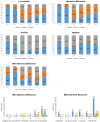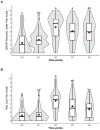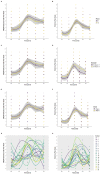Reliability and Validity of UNESP-Botucatu Cattle Pain Scale and Cow Pain Scale in Bos taurus and Bos indicus Bulls to Assess Postoperative Pain of Surgical Orchiectomy
- PMID: 36766253
- PMCID: PMC9913732
- DOI: 10.3390/ani13030364
Reliability and Validity of UNESP-Botucatu Cattle Pain Scale and Cow Pain Scale in Bos taurus and Bos indicus Bulls to Assess Postoperative Pain of Surgical Orchiectomy
Abstract
Pain assessment guides decision-making in pain management and improves animal welfare. We aimed to investigate the reliability and validity of the UNESP-Botucatu cattle pain scale (UCAPS) and the cow pain scale (CPS) for postoperative pain assessment in Bos taurus (Angus) and Bos indicus (Nelore) bulls after castration.
Methods: Ten Nelore and nine Angus bulls were anaesthetised with xylazine-ketamine-diazepam-isoflurane-flunixin meglumine. Three-minute videos were recorded at -48 h, preoperative, after surgery, after rescue analgesia and at 24 h. Two evaluators assessed 95 randomised videos twice one month apart.
Results: There were no significant differences in the pain scores between breeds. Intra and inter-rater reliability varied from good (>0.70) to very good (>0.81) for all scales. The criterion validity showed a strong correlation (0.76-0.78) between the numerical rating scale and VAS versus UCAPS and CPS, and between UCAPS and CPS (0.76). The UCAPS and CPS were responsive; all items and total scores increased after surgery. Both scales were specific (81-85%) and sensitive (82-87%). The cut-off point for rescue analgesia was >4 for UCAPS and >3 for CPS.
Conclusions: The UCAPS and CPS are valid and reliable to assess postoperative pain in Bos taurus and Bos indicus bulls.
Keywords: animal behaviour; animal welfare; domestic cows; farm animals; pain assessment; pain measurement.
Conflict of interest statement
The authors declare no conflict of interest. The funders had no role in the design of the study; in the collection, analyses, or interpretation of data; in the writing of the manuscript; or in the decision to publish the results.
Figures









References
Grants and funding
LinkOut - more resources
Full Text Sources

